brake fluid YAMAHA XMAX 400 2014 Owners Manual
[x] Cancel search | Manufacturer: YAMAHA, Model Year: 2014, Model line: XMAX 400, Model: YAMAHA XMAX 400 2014Pages: 92, PDF Size: 7.3 MB
Page 6 of 92

TABLE OF CONTENTSSAFETY INFORMATION.................. 1-1
Further safe-riding points ............... 1-5
DESCRIPTION.................................. 2-1
Left view ......................................... 2-1
Right view ....................................... 2-2
Controls and instruments ............... 2-3
INSTRUMENT AND CONTROL
FUNCTIONS...................................... 3-1
Immobilizer system......................... 3-1
Main switch/steering lock............... 3-2
Indicator lights and warning
lights............................................ 3-3
Speedometer .................................. 3-5
Tachometer .................................... 3-6
Multi-function display ..................... 3-6
Anti-theft alarm (optional) ............. 3-10
Handlebar switches ...................... 3-10
Front brake lever .......................... 3-11
Rear brake lever ........................... 3-12
ABS (for ABS models) .................. 3-12
Fuel tank cap ................................ 3-13
Fuel ............................................... 3-14
Catalytic converters...................... 3-15
Seat .............................................. 3-16
Storage compartments................. 3-16
Adjusting the shock absorber
assemblies ................................ 3-18
Sidestand ..................................... 3-18
Ignition circuit cut-off system ....... 3-19FOR YOUR SAFETY –
PRE-OPERATION CHECKS............. 4-1
OPERATION AND IMPORTANT
RIDING POINTS................................ 5-1
Starting the engine .......................... 5-1
Starting off ...................................... 5-2
Acceleration and deceleration ........ 5-3
Braking ............................................ 5-3
Tips for reducing fuel
consumption ................................ 5-4
Engine break-in ............................... 5-4
Parking ............................................ 5-5
PERIODIC MAINTENANCE AND
ADJUSTMENT................................... 6-1
Owner’s tool kit ............................... 6-2
Periodic maintenance chart for the
emission control system .............. 6-3
General maintenance and
lubrication chart ........................... 6-4
Removing and installing panels ...... 6-8
Checking the spark plug ............... 6-11
Engine oil and oil filter element ..... 6-13
Final transmission oil..................... 6-15
Coolant.......................................... 6-16
Air filter elements and check
hoses and V-belt case air filter
element ...................................... 6-18
Checking the throttle grip free
play ............................................ 6-20Valve clearance............................. 6-20
Tires .............................................. 6-21
Cast wheels .................................. 6-22
Checking the front and rear brake
lever free play ............................ 6-23
Checking the front and rear brake
pads .......................................... 6-24
Checking the brake fluid level ...... 6-24
Changing the brake fluid .............. 6-26
Checking and lubricating the
cables ........................................ 6-26
Checking and lubricating the
throttle grip and cable ............... 6-26
Lubricating the front and rear
brake levers ............................... 6-27
Checking and lubricating the
centerstand and sidestand........ 6-27
Checking the front fork ................. 6-28
Checking the steering................... 6-29
Checking the wheel bearings ....... 6-29
Battery .......................................... 6-29
Replacing the fuses ...................... 6-31
Replacing a headlight bulb ........... 6-32
Tail/brake light .............................. 6-33
Front turn signal light .................... 6-33
Replacing a rear turn signal light
bulb ........................................... 6-33
Replacing the license plate light
bulb ........................................... 6-34
Auxiliary light ................................ 6-35
Troubleshooting............................ 6-35U1SDE1E0.book Page 1 Monday, September 23, 2013 3:55 PM
Page 37 of 92
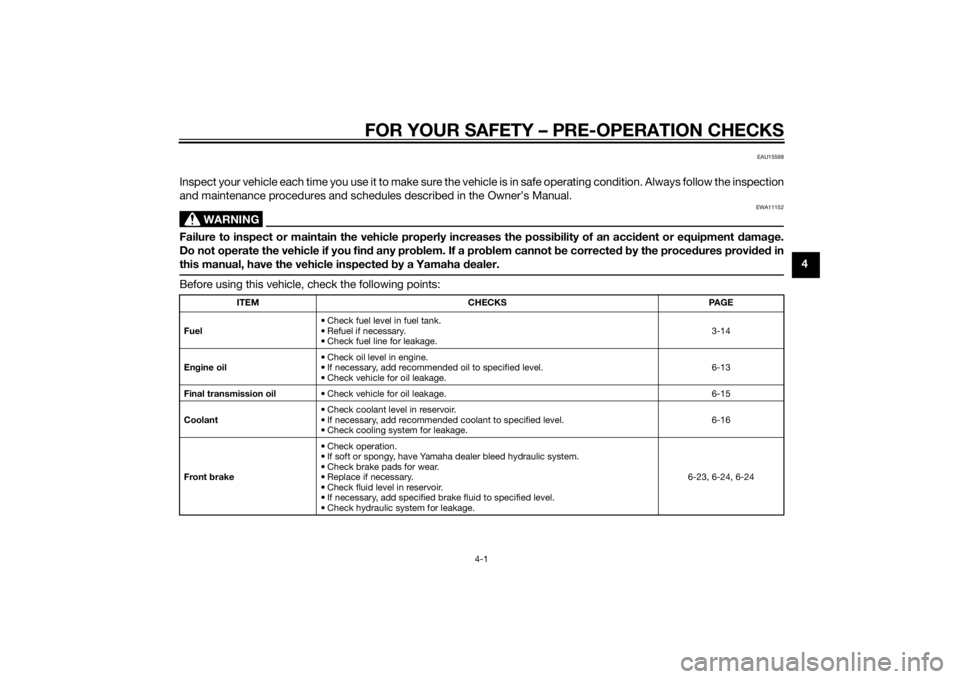
FOR YOUR SAFETY – PRE-OPERATION CHECKS
4-1
4
EAU15598
Inspect your vehicle each time you use it to make sure the vehicle is in safe operating condition. Always follow the inspection
and maintenance procedures and schedules described in the Owner’s Manual.
WARNING
EWA11152
Failure to inspect or maintain the vehicle properly increases the possibility of an accident or equipment damage.
Do not operate the vehicle if you find any problem. If a problem cannot be corrected by the procedures provided in
this manual, have the vehicle inspected by a Yamaha dealer.Before using this vehicle, check the following points:
ITEM CHECKS PAGE
Fuel• Check fuel level in fuel tank.
• Refuel if necessary.
• Check fuel line for leakage.3-14
Engine oil• Check oil level in engine.
• If necessary, add recommended oil to specified level.
• Check vehicle for oil leakage.6-13
Final transmission oil• Check vehicle for oil leakage. 6-15
Coolant• Check coolant level in reservoir.
• If necessary, add recommended coolant to specified level.
• Check cooling system for leakage.6-16
Front brake• Check operation.
• If soft or spongy, have Yamaha dealer bleed hydraulic system.
• Check brake pads for wear.
• Replace if necessary.
• Check fluid level in reservoir.
• If necessary, add specified brake fluid to specified level.
• Check hydraulic system for leakage.6-23, 6-24, 6-24
U1SDE1E0.book Page 1 Monday, September 23, 2013 3:55 PM
Page 38 of 92

FOR YOUR SAFETY – PRE-OPERATION CHECKS
4-2
4
Rear brake• Check operation.
• If soft or spongy, have Yamaha dealer bleed hydraulic system.
• Check brake pads for wear.
• Replace if necessary.
• Check fluid level in reservoir.
• If necessary, add specified brake fluid to specified level.
• Check hydraulic system for leakage.6-23, 6-24, 6-24
Throttle grip• Make sure that operation is smooth.
• Check throttle grip free play.
• If necessary, have Yamaha dealer adjust throttle grip free play and lubricate ca-
ble and grip housing.6-20, 6-26
Wheels and tires•Check for damage.
• Check tire condition and tread depth.
• Check air pressure.
• Correct if necessary.6-21, 6-22
Brake levers• Make sure that operation is smooth.
• Lubricate lever pivoting points if necessary.6-27
Centerstand, sidestand• Make sure that operation is smooth.
• Lubricate pivots if necessary.6-27
Chassis fasteners• Make sure that all nuts, bolts and screws are properly tightened.
• Tighten if necessary.—
Instruments, lights, signals
and switches• Check operation.
• Correct if necessary.—
Sidestand switch • Check operation of ignition circuit cut-off system.
• If system is not working correctly, have Yamaha dealer check vehicle.3-18 ITEM CHECKS PAGE
U1SDE1E0.book Page 2 Monday, September 23, 2013 3:55 PM
Page 47 of 92

PERIODIC MAINTENANCE AND ADJUSTMENT
6-4
6
EAU1770H
General maintenance and lubrication chartNO. ITEM CHECK OR MAINTENANCE JOBODOMETER READING
ANNUAL
CHECK 1000 km
(600 mi)10000 km
(6000 mi)20000 km
(12000 mi)30000 km
(18000 mi)40000 km
(24000 mi)
1 Air filter elements•Replace.√√
2 Air filter check hose• Clean.√√√√√
3V-belt case air filter
element• Clean.√√√√√
4*Front brake• Check operation, fluid level and
vehicle for fluid leakage.√√√√√√
• Replace brake pads. Whenever worn to the limit
5*Rear brake• Check operation, fluid level and
vehicle for fluid leakage.√√√√√√
• Replace brake pads. Whenever worn to the limit
6*Brake hoses• Check for cracks or damage.
• Check for correct routing and
clamping.√√√√√
• Replace. Every 4 years
7*Brake fluid• Replace. Every 2 years
8*Wheels• Check runout and for damage.√√√√
9*Tires• Check tread depth and for dam-
age.
• Replace if necessary.
• Check air pressure.
• Correct if necessary.√√√√√
10*Wheel bearings• Check bearing for looseness or
damage.√√√√
U1SDE1E0.book Page 4 Monday, September 23, 2013 3:55 PM
Page 50 of 92
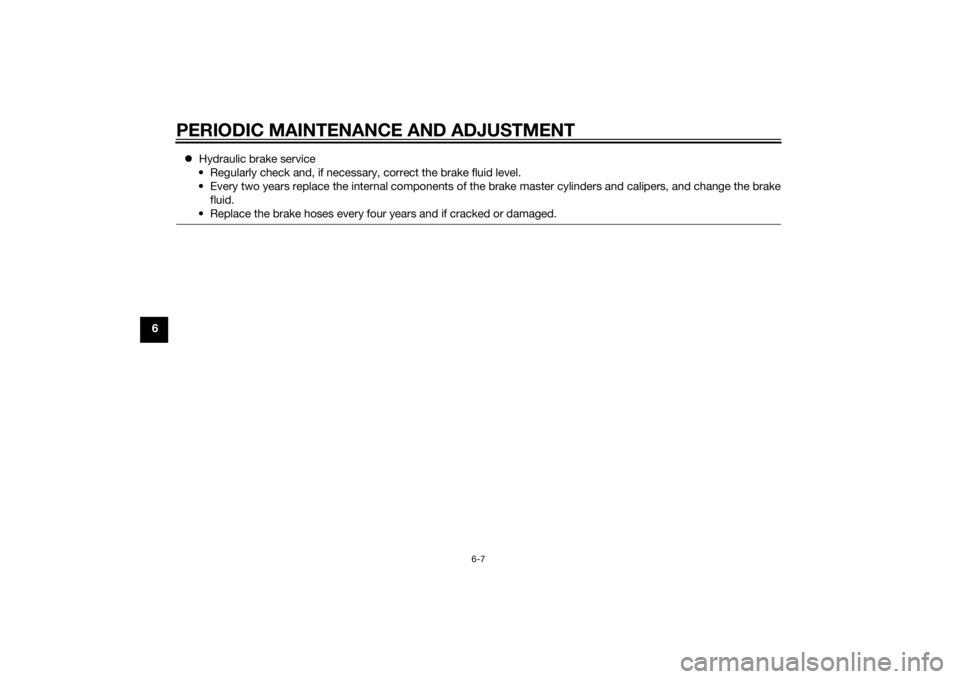
PERIODIC MAINTENANCE AND ADJUSTMENT
6-7
6Hydraulic brake service
• Regularly check and, if necessary, correct the brake fluid level.
• Every two years replace the internal components of the brake master cylinders and calipers, and change the brake
fluid.
• Replace the brake hoses every four years and if cracked or damaged.
U1SDE1E0.book Page 7 Monday, September 23, 2013 3:55 PM
Page 67 of 92
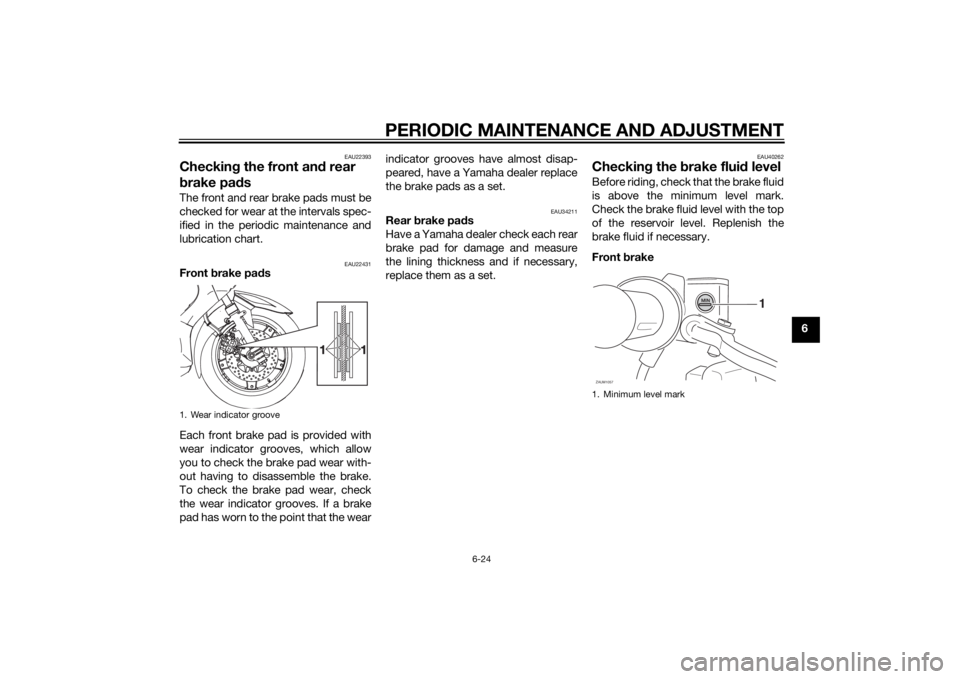
PERIODIC MAINTENANCE AND ADJUSTMENT
6-24
6
EAU22393
Checking the front and rear
brake padsThe front and rear brake pads must be
checked for wear at the intervals spec-
ified in the periodic maintenance and
lubrication chart.
EAU22431
Front brake pads
Each front brake pad is provided with
wear indicator grooves, which allow
you to check the brake pad wear with-
out having to disassemble the brake.
To check the brake pad wear, check
the wear indicator grooves. If a brake
pad has worn to the point that the wearindicator grooves have almost disap-
peared, have a Yamaha dealer replace
the brake pads as a set.
EAU34211
Rear brake pads
Have a Yamaha dealer check each rear
brake pad for damage and measure
the lining thickness and if necessary,
replace them as a set.
EAU40262
Checking the brake fluid levelBefore riding, check that the brake fluid
is above the minimum level mark.
Check the brake fluid level with the top
of the reservoir level. Replenish the
brake fluid if necessary.
Front brake
1. Wear indicator groove
1. Minimum level mark
1
ZAUM1057
U1SDE1E0.book Page 24 Monday, September 23, 2013 3:55 PM
Page 68 of 92
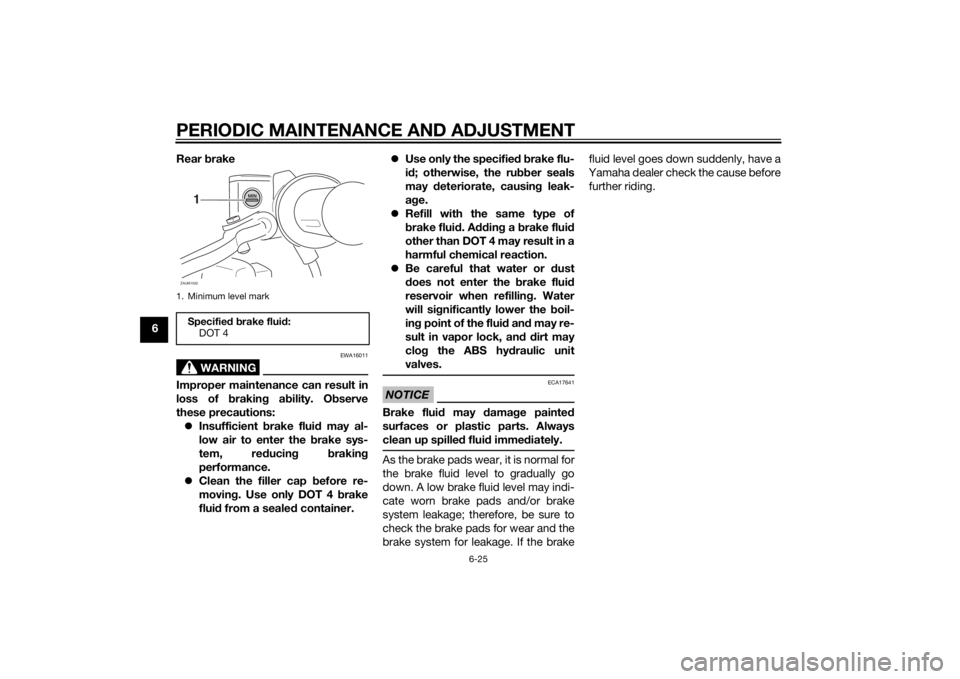
PERIODIC MAINTENANCE AND ADJUSTMENT
6-25
6Rear brake
WARNING
EWA16011
Improper maintenance can result in
loss of braking ability. Observe
these precautions:
Insufficient brake fluid may al-
low air to enter the brake sys-
tem, reducing braking
performance.
Clean the filler cap before re-
moving. Use only DOT 4 brake
fluid from a sealed container.Use only the specified brake flu-
id; otherwise, the rubber seals
may deteriorate, causing leak-
age.
Refill with the same type of
brake fluid. Adding a brake fluid
other than DOT 4 may result in a
harmful chemical reaction.
Be careful that water or dust
does not enter the brake fluid
reservoir when refilling. Water
will significantly lower the boil-
ing point of the fluid and may re-
sult in vapor lock, an
d dirt may
clog the ABS hydraulic unit
valves.
NOTICE
ECA17641
Brake fluid may damage painted
surfaces or plastic parts. Always
clean up spilled fluid immediately.As the brake pads wear, it is normal for
the brake fluid level to gradually go
down. A low brake fluid level may indi-
cate worn brake pads and/or brake
system leakage; therefore, be sure to
check the brake pads for wear and the
brake system for leakage. If the brakefluid level goes down suddenly, have a
Yamaha dealer check the cause before
further riding.
1. Minimum level markSpecified brake fluid:
DOT 4ZAUM1032
1
U1SDE1E0.book Page 25 Monday, September 23, 2013 3:55 PM
Page 69 of 92

PERIODIC MAINTENANCE AND ADJUSTMENT
6-26
6
EAU22733
Changing the brake fluidHave a Yamaha dealer change the
brake fluid at the intervals specified in
the periodic maintenance and lubrica-
tion chart. In addition, have the oil seals
of the master cylinders and calipers as
well as the brake hoses replaced at the
intervals listed below or whenever they
are damaged or leaking.
Oil seals: Replace every two
years.
Brake hoses: Replace every four
years.
EAU23098
Checking and lubricating the
cablesThe operation of all control cables and
the condition of the cables should be
checked before each ride, and the ca-
bles and cable ends should be lubri-
cated if necessary. If a cable is
damaged or does not move smoothly,
have a Yamaha dealer check or re-
place it. WARNING! Damage to the
outer housing of cables may result
in internal rusting and cause inter-
ference with cable movement. Re-
place damaged cables as soon as
possible to prevent unsafe condi-
tions.
[EWA10712]EAU23115
Checking and lubricating the
throttle grip and cableThe operation of the throttle grip
should be checked before each ride. In
addition, the cable should be lubricat-
ed by a Yamaha dealer at the intervals
specified in the periodic maintenance
chart.
The throttle cable is equipped with a
rubber cover. Make sure that the cover
is securely installed. Even though the
cover is installed correctly, it does not
completely protect the cable from wa-
ter entry. Therefore, use care not to
pour water directly onto the cover or
cable when washing the vehicle. If the
cable or cover becomes dirty, wipe
clean with a moist cloth.
Recommended lubricant:
Yamaha cable lubricant or other
suitable cable lubricant
U1SDE1E0.book Page 26 Monday, September 23, 2013 3:55 PM
Page 82 of 92
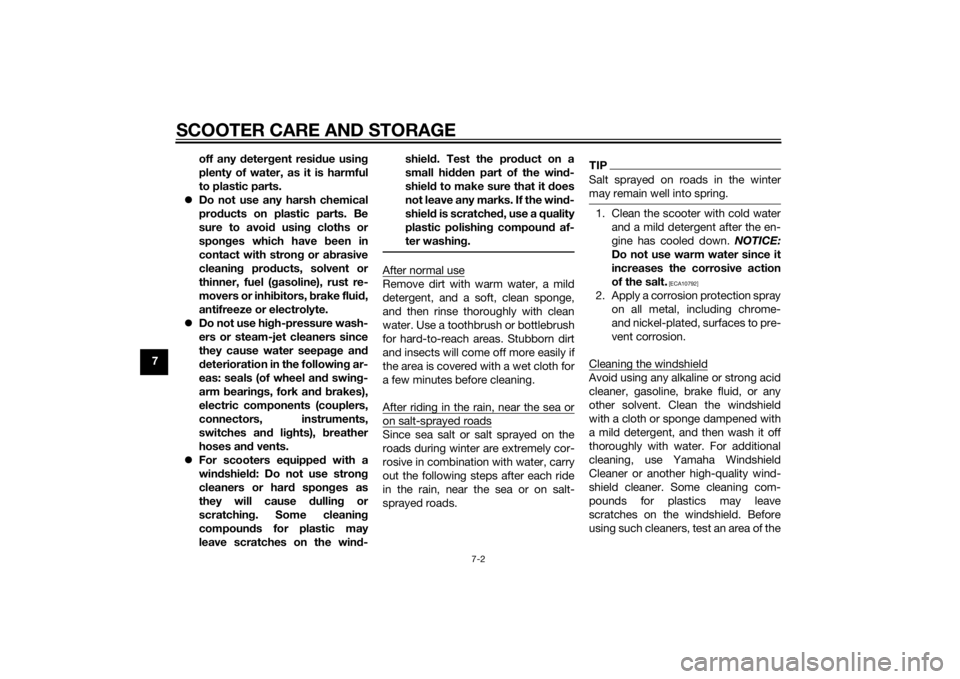
SCOOTER CARE AND STORAGE
7-2
7off any detergent residue using
plenty of water, as it is harmful
to plastic parts.
Do not use any harsh chemical
products on plastic parts. Be
sure to avoid using cloths or
sponges which have been in
contact with strong or abrasive
cleaning products, solvent or
thinner, fuel (gasoline), rust re-
movers or inhibitors, brake fluid,
antifreeze or electrolyte.
Do not use high-pressure wash-
ers or steam-jet cleaners since
they cause water seepage and
deterioration in the following ar-
eas: seals (of wheel and swing-
arm bearings, fork and brakes),
electric components (couplers,
connectors, instruments,
switches and lights), breather
hoses and vents.
For scooters equipped with a
windshield: Do not use strong
cleaners or hard sponges as
they will cause dulling
or
scratching. Some cleaning
compounds for plastic may
leave scratches on the wind-shield. Test the product on a
small hidden part of the wind-
shield to make sure that it does
not leave any marks. If the wind-
shield is scratched, use a quality
plastic polishing compound af-
ter washing.
After normal useRemove dirt with warm water, a mild
detergent, and a soft, clean sponge,
and then rinse thoroughly with clean
water. Use a toothbrush or bottlebrush
for hard-to-reach areas. Stubborn dirt
and insects will come off more easily if
the area is covered with a wet cloth for
a few minutes before cleaning.
After riding in the rain, near the sea oron salt-sprayed roadsSince sea salt or salt sprayed on the
roads during winter are extremely cor-
rosive in combination with water, carry
out the following steps after each ride
in the rain, near the sea or on salt-
sprayed roads.
TIPSalt sprayed on roads in the winter
may remain well into spring.1. Clean the scooter with cold water
and a mild detergent after the en-
gine has cooled down. NOTICE:
Do not use warm water since it
increases the corrosive action
of the salt.
[ECA10792]
2. Apply a corrosion protection spray
on all metal, including chrome-
and nickel-plated, surfaces to pre-
vent corrosion.
Cleaning the windshieldAvoid using any alkaline or strong acid
cleaner, gasoline, brake fluid, or any
other solvent. Clean the windshield
with a cloth or sponge dampened with
a mild detergent, and then wash it off
thoroughly with water. For additional
cleaning, use Yamaha Windshield
Cleaner or another high-quality wind-
shield cleaner. Some cleaning com-
pounds for plastics may leave
scratches on the windshield. Before
using such cleaners, test an area of the
U1SDE1E0.book Page 2 Monday, September 23, 2013 3:55 PM
Page 86 of 92

SPECIFICATIONS
8-2
8
Secondary reduction ratio:
6.643 (31/14 x 42/14)
Transmission type:
V-belt automatic
Operation:
Centrifugal automatic typeChassis:Frame type:
Underbone
Caster angle:
28.00 °
Trail:
100 mm (3.9 in)Front tire:Type:
Tubeless
Size:
120/70-15 M/C 56S
Manufacturer/model:
MICHELIN/CITY GRIP
Manufacturer/model:
SAVA/DIAMONDS MC28Rear tire:Type:
Tubeless
Size:
150/70-13 M/C 64S
Manufacturer/model:
MICHELIN/CITY GRIP
Manufacturer/model:
SAVA/DIAMONDS MC28
Loading:Maximum load:
YP400R 185 kg (408 lb)
YP400RA 181 kg (399 lb)
(Total weight of rider, passenger, cargo
and accessories)Tire air pressure (measured on cold
tires):Loading condition:
0–90 kg (0–198 lb)
Front:
220 kPa (2.20 kgf/cm², 32 psi)
Rear:
250 kPa (2.50 kgf/cm², 36 psi)
Loading condition:
YP400R 90–185 kg (198–408 lb)
YP400RA 90–181 kg (198–399 lb)
Front:
220 kPa (2.20 kgf/cm², 32 psi)
Rear:
250 kPa (2.50 kgf/cm², 36 psi)Front wheel:Wheel type:
Cast wheel
Rim size:
15 x MT3.50Rear wheel:Wheel type:
Cast wheel
Rim size:
13 x MT4.00Front brake:Type:
Dual disc brakeOperation:
Right hand operation
Specified brake fluid:
DOT 4
Rear brake:Type:
Single disc brake
Operation:
Left hand operation
Specified brake fluid:
DOT 4Front suspension:Type:
Telescopic fork
Spring/shock absorber type:
Coil spring/oil damper
Wheel travel:
110.0 mm (4.33 in)Rear suspension:Type:
Unit swing
Spring/shock absorber type:
Coil spring/oil damper
Wheel travel:
92.0 mm (3.62 in)Electrical system:Ignition system:
TCI
Charging system:
AC magnetoBattery:Model:
GT9B-4
U1SDE1E0.book Page 2 Monday, September 23, 2013 3:55 PM